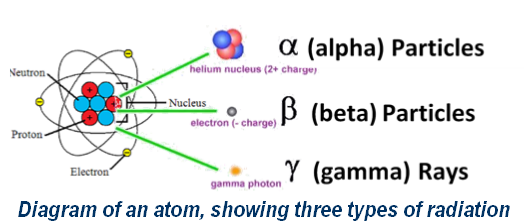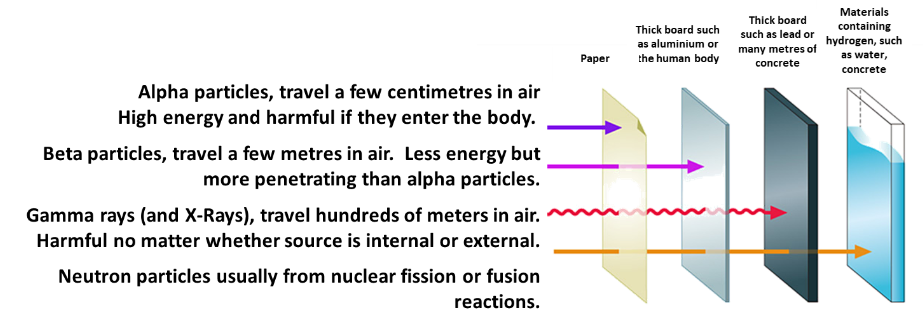Radiation and its Risks (with extracts taken from HSE)
Failing to detect radiation contaminated scrap, can have hidden costs as well as affecting the health and safety of your workforce
Radiation cannot be detected by human sense: it cannot be seen, smelt or felt, but it can damage human tissue and organs, sometimes fatally. Protection by identification is key to remaining safe and following some simple guidelines, as set out by HSE (and your company policy) once a source has been identified and located. It should be normal practice to monitor your product both on entry and exit from the premises.
We are all constantly exposed to natural and man-made radiation, which is collectively known as background radiation. This can vary with a number of factors, such as:
- local rocks and soils, for example granite is more radioactive than some other rocks, so areas of the country build on granite bedrock, such as the South West, naturally have a higher background count;
- cosmic radiation, due to the particles hitting Earth from space (the atmosphere mostly absorbs these); and
- radon gas in the atmosphere, amongst other sources.
- Generally this level of radiation is relatively safe and there is little we can do about it, as we are exposed to it all the time.
All material is made of atoms, which are usually safe and stable. Radiation is caused by the nuclei of unstable atoms, emitting energy in order to become stable. This energy can be emitted as fast moving particles or as waves (rays). There are different types of energy that can be emitted: alpha particles, beta particles, and gamma rays. Sometimes neutron rays and X rays will be emitted.

Each type of radiation has a different amount of energy, will travel different distances and be stopped from travelling by different materials.

Diagram showing how far different types of radiation travel and penetrate materials
How does Radioactive Material enter the Supply Chain?
There have been many incidents worldwide including in the UK, where radioactive materials have become incorporated into the scrap metal chain. The radioactive material tends to originate from the following sources:
- redundant industrial equipment (orphaned sources), which are out of regulatory control (typically containing caesium-138, cobalt-60 or americium-241), such as:
- medical supplies,
- old gauges and dials,
- CRT screens;
- Naturally Occurring Radioactive Material (NORM) (typically containing uranium-238 and thorium-232) or Low Specific Activity (LSA) scale (containing radium-226) found in:
- rocks (especially granite)
- soils (especially clays),
- Oil,
- Paper,
- fertiliser industry;
- specialist alloys such as used in aerospace industry and some welding rods;
- nuclear material waste contamination of imported stainless steel and copper; and
- imported steel through contamination during production.
Sealed radioactive sources are usually housed in an outer casing or container which acts as a shield to the radiation. 'Orphan' sealed sources from redundant industrial plant can present an immediate hazard in the scrap yard if this shielding is missing or damaged on initial receipt. They may present little risk if the container is properly closed and locked.
When scrap is processed and sorted by fragmenting, shearing, milling, cutting, etc, there is a potential for loss of shielding and subsequent significant exposure of employees to external radiation. Loose radioactive material can then contaminate large areas of processing plant including scrap yards with significant potential for exposure of operatives to internal radiation by ingestion or inhalation. If a source is ruptured during smelting, the linings of furnaces, slag- handling facilities, bag houses and the actual product can all become contaminated. Shutdown and decontamination of plant can be very expensive and time consuming.
You can see a range of examples of sources in the RadComm presentation.
The risks associated with radioactive sources are dependent on a variety of factors:
- The type of radiation being emitted by the source;
- The strength of the source (how much radiation it emits, measured in Becquerels (Bq));
- Distance from the source;
- Time of exposure to the source;
- Amount of shielding by other materials from the source.
You can protect yourself by using three principles:
- Shielding:
- Wearing disposable gloves, overalls, overshoes, (disposing of these after use;
- Washing hands before handling food and drink after potential exposure;
- Not eating or drinking where a radioactive source may be present;
- Distance:
- Staying as far away as possible from potential source,
- Using tongs to handle the source;
- Time:
- Keeping exposure time to a potential source to a minimum.

Your Primary Source
For Radiation Detection








Website last updated on: 13 April 2025 Website by Tara Lievesley
RadComm: The Future of Radiation Detection Technology
RadCommGB Ltd, Upper Interfields, Leigh Sinton Road, Malvern. Worcestershire. WR14 1UT  01562 824406.
01562 824406.  Info@radcommgb.com
Info@radcommgb.com